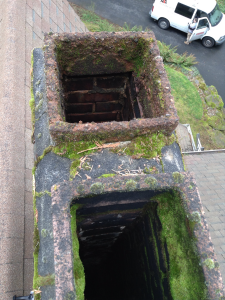When it comes to chimney maintenance, most homeowners understand the important of things like chimney sweepings and inspections. Likewise, it is usually obvious – and sometimes painfully so – when exterior or interior fireplace and chimney masonry needs to be replaced.
One area of your chimney where repairs might not be so obvious is the flue. Because it cannot be seen with the naked eye, most homeowners have no idea what condition their flue is in. This often leads to a nasty surprise if severe flue damage is discovered.
If your flue is damaged and the chimney needs to be relined, it is important not to delay repairs. Because the chimney liner plays such an important role in keeping your family, friends, and home safe it should be repaired as soon as possible.
What does the chimney liner do?
Since the turn of the century, fireplaces have been built using chimney liners. In fact, almost all local and state business codes require chimney liners of some kind. Chimney liners are “A clay, ceramic, or metal conduit installed inside of a chimney, intended to contain the combustion products, direct them to the outside atmosphere, and protect the chimney walls from heat and corrosion.”
The primary purpose of chimney liners is to prevent a transfer of heat from the chimney to the surrounding building materials. Temperatures in the fireplace and chimney can be extremely hot; without a chimney liner, surrounding walls, framing, or insulation would be directly exposed to this heat. According to the National Bureau of Standards, without a chimney liner surrounding building materials can catch fire in as little as three and a half hours when the fireplace is in use.
In addition to protecting against heat transfer, chimney liners also prevent the acidic or corrosive byproducts of combustion from affecting surrounding building materials. While masonry is uniquely designed to withstand the heat created in the fireplace, without a chimney liner the bricks and mortar can be exposed to and easily damaged by these caustic byproducts. An undamaged flue liner protects the masonry of the fireplace and chimney while also helping these byproducts travel safely up and out of the chimney system.
Why do chimneys need relining?
Even though it is out of sight, the chimney liner has the extremely important job of protecting the rest of your home from the hot air, gas, and smoke of the chimney. Because of this, it is important to have it repaired if it is damaged. Unfortunately, due to the way many flues are constructed, simple repairs may not be an option. Instead, a chimney relining can repair the flue damage while helping to reinforce and support the overall chimney structure.
Damaged chimneys can significantly benefit from being relined. In addition to reinforcing the existing flue structure, relined chimneys can improve drafting, decrease safety hazards, and even improve fireplace efficiency.
If you need to have your chimney relined, don’t delay. Contact New Buck Chimney Services today to learn more about the benefits of a relined chimney or to schedule your chimney relining appointment.

